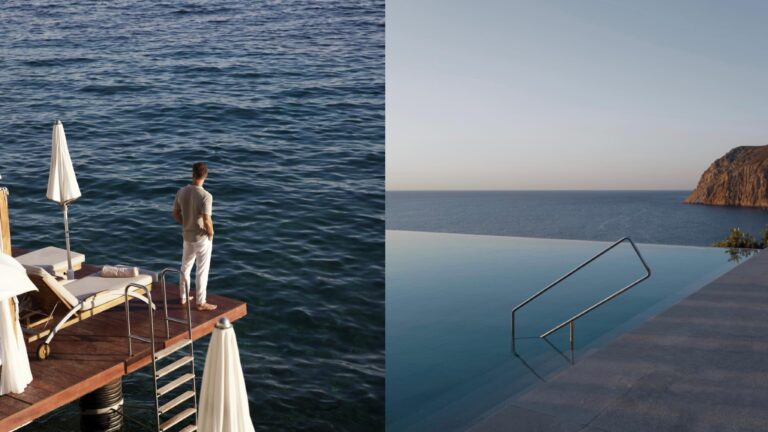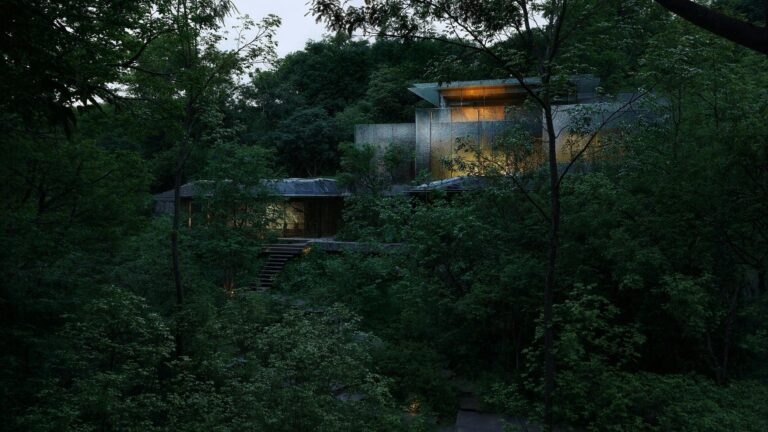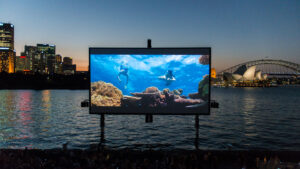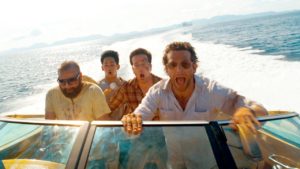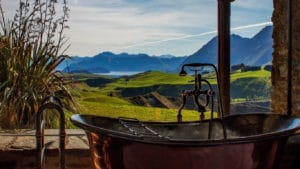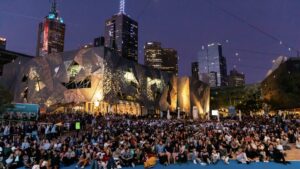The phone buzzed. A familiar name appeared on the screen.
Based on where I ended up after the last call from this number, I knew it was going to be good. I couldn’t answer quick enough.
“I wish I could tell you more mate, really, but I just don’t know,” said Peter Miller, the owner of No Roads Expeditions.
“It’ll be an adventure, I can promise you that much…so, are you in?”
Fast forward six months, I found myself amongst a team of nine Aussies and one Canadian on a Dash-8 flying low on approach into Mount Hagen airport, deep in Papua New Guinea’s Highland region. Clouds billowed passed my window in waves awarding brief glimpses of a thick, wild jungle and its razor-sharp peaks below. The mission? An exploratory summit of a remote 4,000-metre massif that had never been climbed before.
A mountain that had never been climbed before.
Let that sink in for a moment. Forgive my naivety, but even just the thought of there being places on Earth that humans have yet to visit is astounding. We’ve been to the highest point on the planet, the deepest trench in the deepest ocean. Half a century ago, we made it to the moon with less computing power than a modern-day washing machine. And here I was, in 2018, about to set off on an expedition into the unknown.
It soon became clear that not knowing what to expect had been both a blessing and a curse.
An uncertain start
The first Western explorers didn’t arrive in these remote areas of PNG until the late 1930s. Following a sparse German settlement before the subsequent world war, the only geological survey to have ever been conducted in the area was way back in 1975.
It was that same survey that identified the mountain we had set out to climb in 2018. It was called Mount Kabangama and it supposedly stood at 4104 metres above sea level, buried somewhere within layers and layers of jagged ridge lines and jungle that had kept it quiet from even its nearest local villagers.
Our plan was to take a convoy of Land Cruisers along the furthest dirt road possible to the last village on the map. From there, we’d recruit a cadre of local men to join us and set off into the jungle in a rough direction towards the peak. At this point in time, the itinerary was still yet to be confirmed. Our exit strategy from the mountain was still a big uncertainty. Helicopters were the likely option, maybe a little-known remote airstrip if we could find it. It was a loose plan at best, but it was the only plan we had.
That was until we arrived at that last village on the trail, Andkap. They knew we were coming, thanks to a scouting trip by the lead guides a few months earlier. It wasn’t until that very moment we promptly realised that something had been gravely lost in translation.
A map was spread out on a rock. All the men and village elders had gathered around.
“Point yourselves out on this map. Where are we?”
“Here,” said one of the blokes.
There was a pause from the Australians.
“Are you sure?”
Wide-eyed looks were exchanged among the group. The local man had pointed to a village dozens of kilometres from where we thought we were. At the end of the proposed route.
We were in the wrong place trying to find a mountain that they didn’t even know by name.
“Kabangama?”
Nothing. Perhaps the villagers had dubbed it something else. Either way, we were buggered before we’d even begun.
After a while, one man came forward and examined the map more closely. He pointed to the location and shook his head at his comrades. We eventually understood that both the village identified and the one we were standing in shared near-identical names, bar all but two letters. The local men had read the map upside down and just assumed the other village was where we were.
Cue sighs of relief all round. So we were in the right place. Now the real challenge could begin.
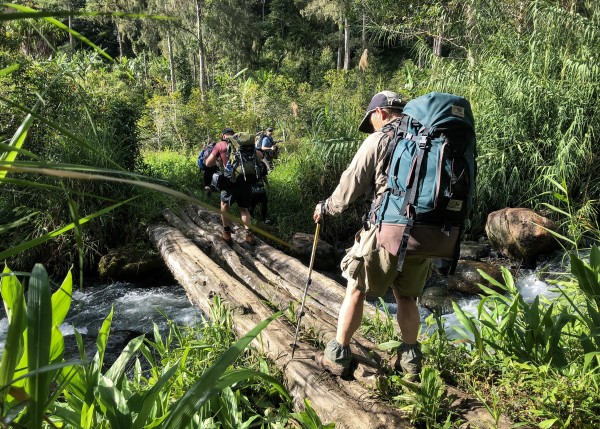
First steps
This isn’t so bad, I thought at first, a fresh surge of confidence in my step. The warmth from the morning’s first light sliced through the valley of lush farmland. Passing the odd hut, crossing the odd river, the trail grew narrower and narrower as the vegetation got higher and higher around us, ultimately swallowing us within an untamed jungle. The warmth and light we were enjoying just moments ago were now sparsely breaking through the canopy to illuminate the treacherous landscape ahead of us. This was well and truly no man’s land.
The goal for day one was the tree-line. We suspected it was at a height of 3300 metres. Eight hours after passing the last village hut, however, and the tree-line was nowhere in sight. We were 1000 vertical metres short, and darkness was creeping up on us, fast.
The locals had taken us along an old hunting route that was barely wider than a single hiking boot. Just a few minutes ahead of us, a handful of porters were hacking away at decades of untouched flora with machetes, forcing a path through the rough undergrowth. Moss and mud covered an ancient mixture of roots, loose soil and dead wood. With every second step, you’d slip, with every third step you’d fall. With every fourth, you’d end up thigh-deep down a hole you thought was a solid footing mere moments before.
The gradient of the climb seemed to only get steeper. The level of concentration necessary was frustrating and unprecedented. Let your mind wander for a second, or take your eyes off the track for too long, and you could twist an ankle, break a leg, or fall down a perilous drop into the valley below.
Beads of sweat clung to my forehead, mixing with sunscreen and insect repellant before cascading down to scorch my eyeballs. My hands and legs were on fire from the wrath of unavoidable stinging nettle that boxed us in from all sides. We had no choice but to push through it. It became abundantly clear that day one was the hardest day I was to ever encounter on a mountain. It also became clear why no one had ever bothered to have a crack at this peak, let alone go through with it.
They’d have to be fucking mental.
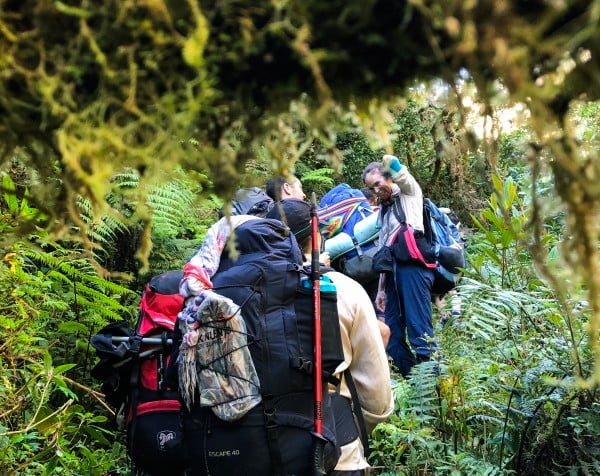
On the fly
Our rough schedule and loose plan had completely gone to shit. We’d only make it to the top of this mountain if the terrain allowed it. On the third day, the odds were stacking up against us hard and fast. Roadblocks were left, right and centre.
“Ah, we’re going to have to go back, not safe,” the lead porter quipped (a little too casually) as we snaked along the side of a risky ridge-line.
I peered down over his shoulder. Nothing. The earth under our feet which barely clung to the cliffside fell away just a stone’s throw ahead of us, opening up a chasm of space that dropped hundreds of metres down to the valley below. Everything about this moment felt like a scene in an early-2000’s adventure movie, where the expedition to find the lost city of gold comes to a grinding halt. It definitely wasn’t the place to lose your balance.
That’s it, we’re done, I thought. There was no way we could get across this.
As we retreated to discuss our next move, the local boys had already gone into full action man mode, barking orders at each other and hacking away at nearby trees, presumably to somehow construct a way across.
Within 20 minutes a bridge (of the loosest definition) and a rope were now miraculously connecting us with our way forward. Grasping the line with two hands, my body facing the mountain and boots perpendicular to the logs, I shuffled cautiously across the gap. My heart was pounding in my ears, intermittently drowned out by heavy breaths. I made the mistake of briefly looking down.
Come on John, you never look down. Just three medium-sized tree branches held me from a drop of no return, bending and straining under my weight with each step. I found myself praying to nine different deities that my muddy boots wouldn’t slip out from under me. Not right now.
Jesus, I thought, if my mother could see me now she’d kill me herself.
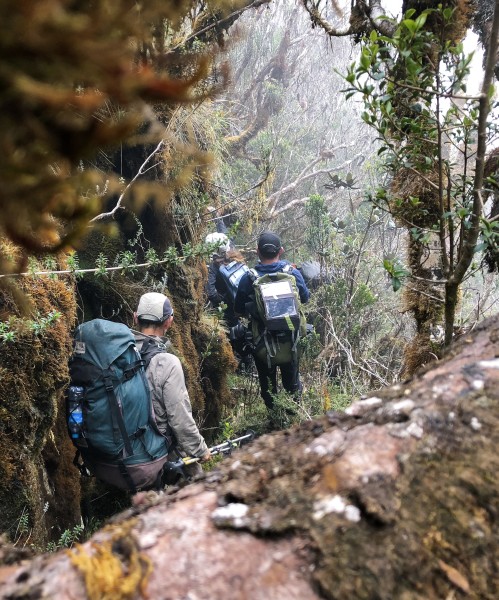
Target in sight
That very same day, after surviving a variety of the mountain’s initiation rituals, we eventually laid eyes on Kabangama’s peak for the first time. And that very same day, our worst fears were seemingly realised.
Not knowing what you’re climbing leaves the fate of a successful summit to the mercy of nature, even more so than ever. Provided we navigated the mess that was the unhinged jungle, scrambled and scurried across sketchy ridge-lines and bush-bashed our way through thorn-riddled forests, it was entirely possible that the summit of this mountain would, quite simply, be impossible to reach. Up until now, we were essentially in the dark.
As Kabangama’s peak finally made itself known, a dreaded feeling of despair flooded through me. Four tireless days had been spent just getting within line of sight of this mountain, and I stood there, still miles away, now staring at a huge lava rock tower jutting out from the top of it.
It went straight up. For a height of about 80 metres or so. Sheer rock.
There was no way in hell any of us were getting to the top of it. I let out a sigh of defeat as I dropped to the ground to take a rest. Ah well, I thought, this was what we’d signed up for. Nothing had been guaranteed. Our only hope was the slim possibility that the peak’s ridge behind it was actually the higher point, but from this angle, it looked unlikely.
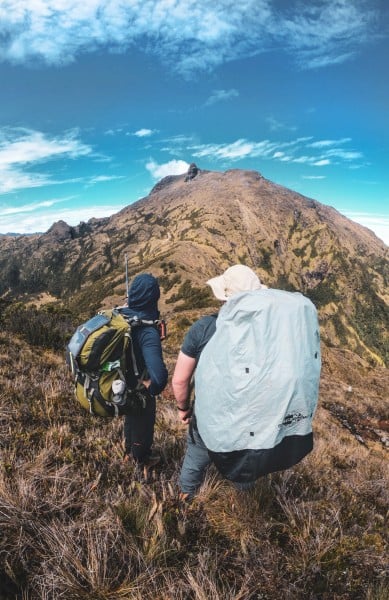
Summit day
When dawn cracked the horizon on summit day, the noticeably thinner air pierced my warm clothes without prejudice. A sharp reminder that I was now well and truly awake – and only a few hundred metres shy of our goal.
With my head down, I put one determined foot in front of the other. The dramatic rock tower was even more daunting now, confirming assumptions that it was just as impossible as it had first looked. A small part of me was quietly positive that the true high point of Kabangama might still be the ridge behind it. But we weren’t to know until we literally took the last step.
Six days, dozens of kilometres and a bunch of near trip-ending obstacles later, it all came down to the final few steps. Of course it did.
A blanket of fairy floss cloud in the valley far below lifted with the sun, lapping at our heels as it chased us to the summit before abruptly dissipating into nothing.
As we neared the peak, well above 4000 metres now, an eager energy overcame the team and filled our spirits with a second wind, spurring us on. Faster now, we scrambled and climbed our way up the last few metres.
The far side of Kabangama was then revealed – and our eyes were the first to ever see it.
The dramatic drop off into the overwhelmingly vast wilderness below made my head spin. I leant back to steady myself and take in the incredible 360 degrees of rock and jungle in every direction.
There was not a single man-made feature in sight. I called out to the team.
“Altitude check?”
4118-metres above sea level.
Higher than the official survey. I looked back over my shoulder to the rock tower a little further along the ridge. I was almost bang-on eye-level with its summit. Was it higher than us? Quite possibly, by a few metres perhaps. But we’d never know for sure, at least not by how much.
I spent what could have been the next 15 minutes or two hours (I couldn’t even tell you) sat on the peak enjoying the warmth of the early morning sun on my face, like one I’d never experienced in my life, taking in a rare vista of rugged beauty that few would ever enjoy. Reflecting on the week that was, heavy on the chaos, each member of the team said a few words to a video camera, telling the world who they were and where they were from.
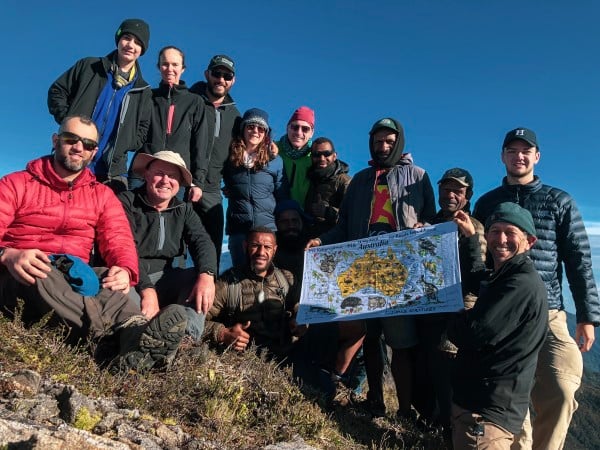
It forced me to think about why I was where I was in that exact moment. The fact that I was on a mountain in the middle of absolutely nowhere, in a country that – let’s face it – wouldn’t top most people’s bucket lists, hardly mattered at all. And I’ll be the first to admit; in retrospect, it wasn’t the destination that enticed me to say yes on that phone call all those months prior. As amazing as it turned out to be.
Even in the farthest-flung spots around the globe, our experiences have come to be diluted and influenced by expectations set through our feeds. Where to stay, where to find the best happy hour, where the best ‘gram shot might be. All of this information is only ever a few taps away. In a sense, travel for the masses has become a shopping list, a one-up game of ticking boxes. We’re constantly chasing someone else’s dream. So what happens when there aren’t any boxes to tick? When you need to draw your own, with no prior prejudice to skew your desires? Add an element of risk, a high degree of uncertainty and put the fate of a trip in the hands of something bigger than yourself, you might find yourself admiring the world from a perspective that can’t be summarised in a caption. It’s something raw. Visceral. The very definition of singular.
This expedition could have been a massive failure. On more than one occasion, it should have been. But what I love most about this experience is that a kick-ass story was inevitable. Win or lose. And it’s shit like that you simply can’t script. If everything is already spelt out for you, what’s the point of it all?
Removing the SD card from the camera, we loaded it into a time capsule stuffed with a signed map of Australia among other things, sealing it tight to protect it from the peak’s exposure to the elements. We then logged its GPS coordinates and took our final photos before beginning the slog down off the mountain.
As if on cue, the heavens opened up and rain began to ferociously baptise us. This journey up was tough, to say the least – but essentially, we were still only halfway.
I let out a small smile and put my head down, resuming my constant state of concentration. Mum’s going to lose her shit at me if I kill myself on the way down.
No Roads Expeditions have decided to offer Mount Kabangama as part of an upcoming ‘Three Peaks’ trip, one of which is PNG’s highest mountain. Just one of these peaks was hell and back, so you better froth a challenge if you’re going to tackle all three.
Head to their website for a browse through the full list of adventures. Big thanks to our guides Peter & Adrian for keeping their cool and getting us up and back safely.
The North Face supplied our kit to complete the climb in comfort, shop their full range here.

